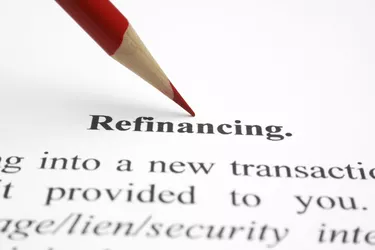
You're more likely to qualify for a purchase or refinance home loan if you understand the loan process, including the terms and the basic elements of that process. Also, your ability to qualify for a loan is dependent on your answers to a few questions that allow a lender to get a handle on the maximum amount of the loan for which you will qualify. For instance, the value of any loan, including the limited cash-out refinance loan, is partly dependent on the cash you have in hand for a down payment and closing costs, as well as your or loan-to-value ratio.
The limited cash-out refinance home loan is one of several types of refinance loans but it's a useful one for someone who needs access to cash.
Video of the Day
Video of the Day
Interest Rates and Refinancing
A decrease in lending interest rates triggers a search by many homeowners for a mortgage refinance option that will make more cash available to them on a monthly basis or grant the homeowner some other more favorable financing terms. Equally appealing is an option to take out a mortgage for a greater dollar amount than that which you owe on your current mortgage.
The homeowner's eagerness to revise a mortgage loan's terms can be hampered, however, by the terms of the existing mortgage. For instance, a mortgage might prohibit home refinancing.
Function of Limited Cash-Out Refinance Loan
The limited cash-out refinance loan is an option to refinance your existing mortgage by replacing it with a new one. This approach results in a new loan with a face value that's greater than the amount you owe on your existing loan. But, this type of refinance loan grants you access to additional cash at the time of the refinance loan's closure.
In general, a homeowner pursues the option to refinance her home – replace the existing mortgage with a new one – to acquire more favorable mortgage terms. For instance, you might decrease the mortgage interest rate and lower your monthly mortgage payment. Alternatively, you might renegotiate the loan's term or omit a property owner from the mortgage.
With a limited cash-out refinance mortgage, you may receive a small amount of cash back. The lender may also refund any overpayment of fees and charges that are due to federal or state laws or regulations.
Limited Cash-Out Refinance Explained
The cash-out refinance option is particularly beneficial if there is a significant decline in interest rates or if a borrower experiences a financial crisis, such as that which can result from a health emergency.
Access to Limited Cash-Out Refinancing
To determine her access to this refinance option, the homeowner must reference her mortgage contract, which stipulates when and on what basis the homeowner might refinance her current mortgage loan. These contractual terms, including those imposed by Fannie Mae, can limit the homeowner's refinancing options, including access to limited cash-out refinancing.
Cost of Limited Cash-Out Refinancing
When available to the homeowner, limited cash-out mortgage refinancing grants the owner access to cash, but not without fees and other costs. These costs include interest and closing fees.
At closing, the borrower receives cash, net of fees and other costs, that she can use to pay down other debt or pay for another purchase.
Limited Cash-Out Refinancing Process
To obtain a cash-out refinance mortgage, the borrower identifies a lender that's interested in issuing her refinancing mortgage. Once the borrower submits the loan application, the lender evaluates the balance of the existing mortgage, the loan's terms, the loan's payoff value and the borrower's credit profile.
Based on the research, the lender makes an offer to pay off the borrower's existing loan and issue a new one. This offer will reference a proposed monthly installment plan and the costs and fees related to paying off the existing mortgage and issuing a new one.
Depending on the loan-to-value ratio of the new loan, which could be 125 percent, the existing mortgage might be paid and the new loan's face value might be equal to 125 percent of the mortgaged home's value. Some portion of the difference between the mortgage payoff and the loan's value is issued to the borrower as cash.
Limited Cash-Out Refinance Example
Assume that in the past you purchased a house with a value of $400,000 by making a $200,000 down payment and signing a $200,000 mortgage note. Also assume that the mortgage balance is $100,000, the current value of the property is $470,000, and the interest rate has fallen from 7 percent to less than 2 percent.
In this case, your equity in your home is $300,000, so upon your application for a limited cash-out refinance loan, you may be approved for a cash-out payment equal to some portion of that equity.